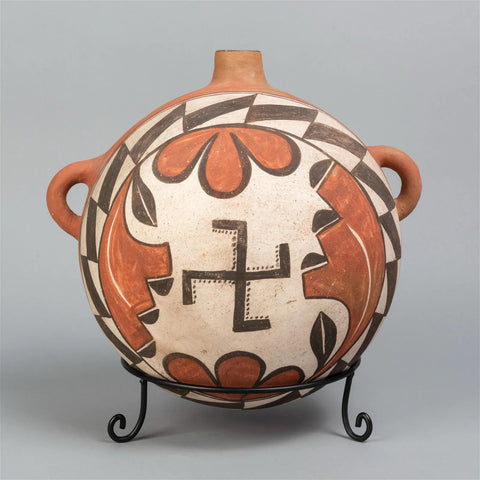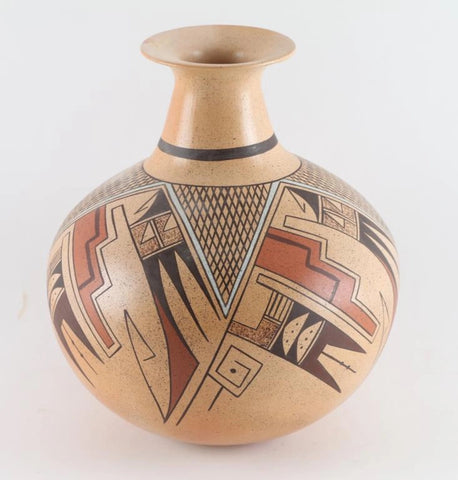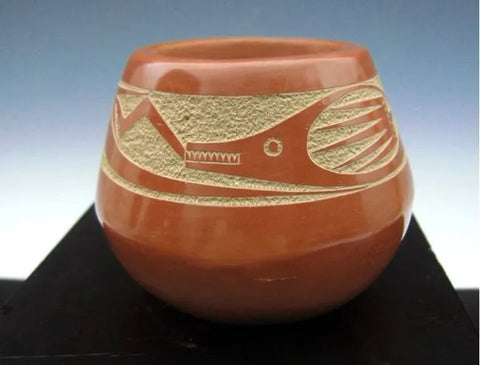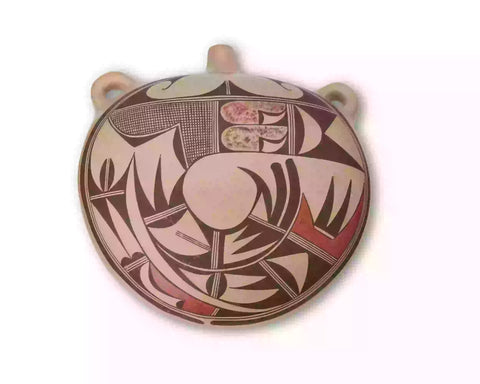
Santa Clara Blackware Pottery, Lorencita N Tafoya, Ca 1960's, #1274
$ 1,500.00
Santa Clara Blackware Bowl, by Lorencita Naranjo Tafoya (1899-1987) , Ca 1960's, #1274
Description: #1274 Native American Vintage Santa Clara Blackware Pottery Bowl, by Lorencita Naranjo Tafoya (1899-1987) , Ca 1960's, a fine example of her blackware.
Dimensions: 4" x 8.5"
Condition: Has some minor surface imperfections, but overall is in very fine condition.
Lorencita Naranjo was born on the Santa Clara pueblo on May 25, 1899, the daughter of Valentine Naranjo (1875-by 1930) and Nestora Gutierrez (1879-1980). She was presumably taught the craft of pottery from her mother, an accomplished potter (best known as Nestora Gutierrez Silva, after her second husband Adam Silva, whom she married after Lorencita's father's death.) Lorencita married first Epifiano Tafoya (1880-1924) and second, after his death, his brother Margarito Tafoya (1888-1980); they were the sons of Manuel Tafoya and Maria Deluvina Naranjo, and related to the great Margaret Tafoya (1901-2001), acknowledged as the matriarch and best of the Santa Clara potters. It was in this great extended family of women artists that Lorencita flourished, enjoying a near fifty-year career spanning from the 1920's through the 1970's. She was a favorite subject of pueblo photographer T. Harmon Parkhurst, whose portraits capture a shy beauty (in sharp contrast with Parkhurst's bold and iconic images of her mother, Nestora, another favorite subject.) Lorencita died on December 16, 1987. Her works can be found in the Museum of Indian Arts and Cultures, Santa Fe, New Mexico and the Lowell D. Holmes Museum of Anthropology at Wichita State University (Source: Desert West Auctions).
“Pueblo pottery is made using a coiled technique that came into northern Arizona and New Mexico from the south, some 1500 years ago. In the four-corners region of the US, nineteen pueblos and villages have historically produced pottery. Although each of these pueblos use similar traditional methods of coiling, shaping, finishing and firing, the pottery from each is distinctive.
Various clay's gathered from each pueblo’s local sources produce pottery colors that range from buff to earthy yellows, oranges, and reds, as well as black. Fired pots are sometimes left plain and other times decorated—most frequently with paint and occasionally with appliqué. Painted designs vary from pueblo to pueblo, yet share an ancient iconography based on abstract representations of clouds, rain, feathers, birds, plants, animals and other natural world features.
Tempering materials and paints, also from natural sources, contribute further to the distinctiveness of each pueblo’s pottery. Some paints are derived from plants, others from minerals. Before firing, potters in some pueblos apply a light colored slip to their pottery, which creates a bright background for painted designs or simply a lighter color plain ware vessel. Designs are painted on before firing, traditionally with a brush fashioned from yucca fiber.
Different combinations of paint color, clay color, and slips are characteristic of different pueblos. Among them are black on cream, black on buff, black on red, dark brown and dark red on white (as found in Zuni pottery), matte red on red, and polychrome—a number of natural colors on one vessel (most typically associated with Hopi). Pueblo potters also produce undecorated polished black ware, black on black ware, and carved red and carved black wares.
Making pueblo pottery is a time-consuming effort that includes gathering and preparing the clay, building and shaping the coiled pot, gathering plants to make the colored dyes, constructing yucca brushes, and, often, making a clay slip. While some Pueblo artists fire in kilns, most still fire in the traditional way in an outside fire pit, covering their vessels with large potsherds and dried sheep dung. Pottery is left to bake for many hours, producing a high-fired result.
Today, Pueblo potters continue to honor this centuries-old tradition of hand-coiled pottery production, yet value the need for contemporary artistic expression as well. They continue to improve their style, methods and designs, often combining traditional and contemporary techniques to create striking new works of art.” (Source: Museum of Northern Arizona)
----------
View the other items in my shop: http://www.etsy.com/shop/CulturalPatina?ref=shopsection_shophome_leftnav
Description: #1274 Native American Vintage Santa Clara Blackware Pottery Bowl, by Lorencita Naranjo Tafoya (1899-1987) , Ca 1960's, a fine example of her blackware.
Dimensions: 4" x 8.5"
Condition: Has some minor surface imperfections, but overall is in very fine condition.
Lorencita Naranjo was born on the Santa Clara pueblo on May 25, 1899, the daughter of Valentine Naranjo (1875-by 1930) and Nestora Gutierrez (1879-1980). She was presumably taught the craft of pottery from her mother, an accomplished potter (best known as Nestora Gutierrez Silva, after her second husband Adam Silva, whom she married after Lorencita's father's death.) Lorencita married first Epifiano Tafoya (1880-1924) and second, after his death, his brother Margarito Tafoya (1888-1980); they were the sons of Manuel Tafoya and Maria Deluvina Naranjo, and related to the great Margaret Tafoya (1901-2001), acknowledged as the matriarch and best of the Santa Clara potters. It was in this great extended family of women artists that Lorencita flourished, enjoying a near fifty-year career spanning from the 1920's through the 1970's. She was a favorite subject of pueblo photographer T. Harmon Parkhurst, whose portraits capture a shy beauty (in sharp contrast with Parkhurst's bold and iconic images of her mother, Nestora, another favorite subject.) Lorencita died on December 16, 1987. Her works can be found in the Museum of Indian Arts and Cultures, Santa Fe, New Mexico and the Lowell D. Holmes Museum of Anthropology at Wichita State University (Source: Desert West Auctions).
“Pueblo pottery is made using a coiled technique that came into northern Arizona and New Mexico from the south, some 1500 years ago. In the four-corners region of the US, nineteen pueblos and villages have historically produced pottery. Although each of these pueblos use similar traditional methods of coiling, shaping, finishing and firing, the pottery from each is distinctive.
Various clay's gathered from each pueblo’s local sources produce pottery colors that range from buff to earthy yellows, oranges, and reds, as well as black. Fired pots are sometimes left plain and other times decorated—most frequently with paint and occasionally with appliqué. Painted designs vary from pueblo to pueblo, yet share an ancient iconography based on abstract representations of clouds, rain, feathers, birds, plants, animals and other natural world features.
Tempering materials and paints, also from natural sources, contribute further to the distinctiveness of each pueblo’s pottery. Some paints are derived from plants, others from minerals. Before firing, potters in some pueblos apply a light colored slip to their pottery, which creates a bright background for painted designs or simply a lighter color plain ware vessel. Designs are painted on before firing, traditionally with a brush fashioned from yucca fiber.
Different combinations of paint color, clay color, and slips are characteristic of different pueblos. Among them are black on cream, black on buff, black on red, dark brown and dark red on white (as found in Zuni pottery), matte red on red, and polychrome—a number of natural colors on one vessel (most typically associated with Hopi). Pueblo potters also produce undecorated polished black ware, black on black ware, and carved red and carved black wares.
Making pueblo pottery is a time-consuming effort that includes gathering and preparing the clay, building and shaping the coiled pot, gathering plants to make the colored dyes, constructing yucca brushes, and, often, making a clay slip. While some Pueblo artists fire in kilns, most still fire in the traditional way in an outside fire pit, covering their vessels with large potsherds and dried sheep dung. Pottery is left to bake for many hours, producing a high-fired result.
Today, Pueblo potters continue to honor this centuries-old tradition of hand-coiled pottery production, yet value the need for contemporary artistic expression as well. They continue to improve their style, methods and designs, often combining traditional and contemporary techniques to create striking new works of art.” (Source: Museum of Northern Arizona)
----------
View the other items in my shop: http://www.etsy.com/shop/CulturalPatina?ref=shopsection_shophome_leftnav
Related Products
Sold out












